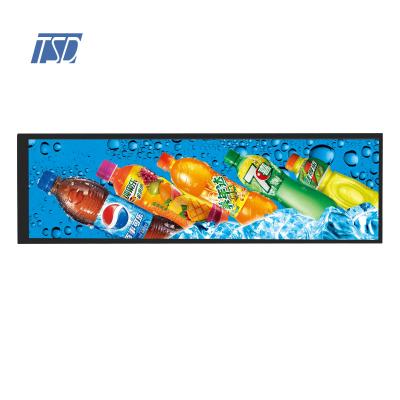Description:
TST080IA-15A is 8 inch 800x480 resolution lcd tft module with LVDS interface, support 8-bit, DE mode, JEIDA/VESA format. Operating Ambient Temperature is -30 to 85°C, storage temperature is -40 to 90°C. Outline LCM is 187.4x118x6.3mm, bezel opening is 177.2x107.4mm, AA is 174x104.4mm. Display mode is Normally Black, Transmissive, AAS. Backlight power consumption is 4.32 W (Typ.)/ 4.6 W(Max), brightness is 920 cd/m2 typically.
Drawing:

Specifications:
| General Specification | ||
| Part No. | TST080IA-15A | |
| Outline Dimension(mm) | 187.4x118x6.3mm | |
| Active Area(mm) | 174x 104.4mm | |
| Resolution(dots) | 800x480 | |
| Operating temperature(°C) | -30 ~ +85°C | |
| Storage temperature(°C) | -40 ~ +90°C | |
| Number of Pixel(pixels) | 800(H)xRGBx480(V) | |
| Touch panel | without | |
| Brightness | 920 cd/m2 | |
| Pixel arrangement | RGB-stripe | |
| Display mode | Normal black,IPS, 8 inch TFT | |
| Surface treatment | Antiglare | |
| View direction | All |
|
| Weight(g) | TBD | |
| Power Consumption(w) | Panel | TBD(Typ.) |
| B/L system | TBD(Typ.) | |
| Interface | LVDS | |
| Module lifetime(Hours) | 30,000 | |
| Pins Description | ||
| Pin No. | Symbol | Description |
| 1 | GND | Ground |
| 2 | VDD | Digital power(3.3V). |
| 3 | VDD | Digital power(3.3V). |
| 4 | VDD | Digital power(3.3V). |
| 5 | GSPD | Gate scan down start signal (For fail safe). |
|
6 |
NC (TSD OTP pin) | OTP power pin, please keep floating. |
| 7 | GND (TSD SDI pin) | Serial communication data input pin, please setting for GND |
| 8 | NC (TSD SDO pin) | Serial communication data output pin, please keep floating |
| 9 | GND (TSD SCL pin) | Serial communication clock input pin, please setting for GND. |
| 10 | VDD(TSD CS pin) | Serial communication chip selection pin, please setting for VDD. |
| 11 | SSCEN | SSCG enable/disable setting |
| 12 | UD | Vertical scan direction |
| 13 | STBYB(MUTE) | Standby mode |
| 14 | RESET | Global reset pin |
| 15 | LR | Horizontal scan direction |
| 16 | LVFMT | VESA/JEIDA format selection pin |
| 17 | BLKINSER | For DE mode skipped function, please setting for GND. Normal display using, please setting for VDD |
| 18 | GND | Ground |
| 19 | LVDS D+ | LVDS data D+. |
| 20 | LVDS D- | LVDS data D- |
| 21 | GND | Ground |
| 22 | LVDS CLK+ | LVDS CLK+ |
| 23 | LVDS CLK- | LVDS CLK- |
| 24 | VSFB | Ground |
| 25 | LVDS C+ | LVDS data C+ |
| 26 | LVDS C- | LVDS data C- |
| 27 | GND | Ground |
| 28 | LVDS B+ | LVDS data B+. |
| 29 | LVDS B- | LVDS data B-. |
| 30 | GND |
Ground
|
| 31 | LVDS A+ | LVDS data A+ |
| 32 | LVDS A- | LVDS data A- |
| 33 | GND |
Ground
|
| 34 | GND (TSD test pin) |
TSD test pin(BISTEN), please setting for GND
|
| 35 | LED1- | Negative backlight voltage. |
| 36 | LED1- | Negative backlight voltage. |
| 37 | LED1- | Negative backlight voltage. |
| 38 | GND | Ground |
| 39 | LED+ | Positive backlight voltage |
| 40 | LED+ | Positive backlight voltage |
Features:
1. High contrast. The contrast value is defined as the ratio of the maximum brightness value (complete white) divided by the minimum brightness value (complete black). Generally speaking, the minimum contrast value acceptable to the human eye is approximately 250:1. High contrast helps you see the display clearly when the light is strong.
2. High dynamic HDR. Picture display quality requires a comprehensive balance, especially the real feeling and coordination of the image. This concept is HDR (High Dynamic Range). Its actual effect is that the moon is brighter in bright places and darker in dark places. The details of both bright and dark places are well displayed.
3. Wide color gamut. High-resolution displays may need to be upgraded from 18-bit red-green-blue (RGB) to 24-bit RGB to achieve a wider color gamut. High color gamut is a very important indicator for improving display effects
4. Fast response time and refresh rate. Smart cars, especially autonomous driving, need to collect road information in real time and promptly remind the driver at critical times. Fast response and refresh avoid lags in information delivery and are critical for warning indicators and navigation features such as live maps, traffic updates and backup cameras.
5. Anti-glare and reduce reflection. In-vehicle displays provide critical vehicle information to the driver and need to not reduce visibility due to ambient light conditions, especially bright sunlight during the day. Of course, the anti-glare coating on its surface must not impede visibility (required to eliminate "flicker" interference).
6. Low energy consumption. The significance of low energy consumption is that it can reduce vehicle energy consumption, especially for new energy vehicles, which can use more electric energy for mileage; in addition, low energy consumption means reducing heat dissipation pressure, which has positive significance for the entire vehicle.
 Email : info@tslcd.com
Email : info@tslcd.com Tel : +86-755-28225963
Tel : +86-755-28225963



















